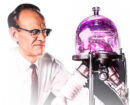
If you’ve read anything about the promise of nuclear fusion, one of the words you encounter most frequently is “safe.” As in nuclear fusion will one day be a “clean, safe, and inexhaustible…” source of nuclear energy.
Yeah, well, maybe. Relatively speaking.
Compared to the nuclear reactors online today, yes, fusion is probably “safer” than fission.
For starters, you don’t have all the fuel present in the reactor the entire time – as you do with a fission reactor – so there is no danger of coolant breakdown, overheating and meltdown. (I’m tempted to draw this analogy: a fission reactor is a bit like putting your automobile engine inside the gas tank. What could possibly go wrong?)
To the contrary, all fusion experiments to date have involved vacuum chambers – the object is to have next-to-nothing in the chamber itself, and then admit only as much nuclear fuel as it takes to generate or sustain a reaction. (Following the automobile engine analogy a little further, a fusion reactor would be more like the cylinder, where only a tiny amount of explosive fuel vapor is admitted to the chamber to ignite the combustion that makes the whole thing go ’round). With a fusion reactor, the worst that could likely happen in the event of an accident is that the reaction chamber would rupture, the vacuum is lost, the reaction ceases, and a tiny bit of gas is released into the atmosphere. Not really much of a problem when measured against the “China Syndrome” scale of a potential fission reactor accident (see Fukushima, Chernobyl, Three Mile Island).
But let’s not kids ourselves that nuclear fusion is entirely “safe.”
First, we are still dealing with all the forces that bind atomic nuclei, and the radiation and particles that are released when atoms are split or combined.
Indeed, the whole way we measure fusion – by the quantity of neutrons produced – ventures into a realm that is potentially entirely lethal. In most of the experimental installations that are discussed here at Fusor.net, the level of neutron output is sufficiently low that there is no danger to being in the vicinity of the reactor for relatively short periods. But getting anywhere close to a self-sustaining reaction produces a neutron flux many orders of magnitude – i.e. in the trillions or even quadrillions – of neutrons per second. And as Doug Coulter’s recent experience demonstrates, “safe” is not one of the words that would describe that level of output.
In addition to the neutron flux, there are the X-rays and the gamma rays that have to be shielded.
And then of course there are the extremely high voltages – i.e. tens of thousands of volts – that operate a fusor. Be very careful what you touch…
So before plunging into one of these projects, it can be worth your time and effort to explore the forums for the myriad safety considerations that must be taken into account before building and operating your very own nuclear fusion reactor.
A simple search reveals that to date there are more than TWELVE HUNDRED posts that invoke the word “safety.” What is interesting is that, near as I can tell, there is no “FAQ” set that specifically addresses the safety considerations that should be taken in to account when building and operating one of these things.
Perhaps a few advanced searches can narrow the subject down:
There are 400+ posts that address “voltage” safety;
There are 170+ posts that address “neutrons” safety;
There are 150+ posts that address “X-rays” safety;
There are 280+ posts that address “vacuum” safety.
So, please, new users especially, avail yourselves to some of this material before embarking on a project with the blanket, unexamined assumption that nuclear fusion is perfectly “safe.” You’ll be glad you did…
